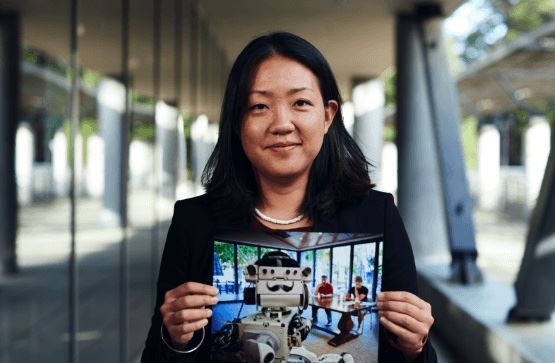Leila Takayama is a human-robot interaction researcher from the University of California, Santa Cruz. In this article with Open Source Stories Leila explains why it’s important for robots to stay “boring” …
I love boring robots. I want my robots to do their jobs without being divas.
Our fancy, “automatic” coffee machine at Willow Garage (a US tech start-up) was constantly demanding our help, using imperative text on its little screen.
Fill beans! Empty tray! (Do it now, human!) I have enough devices to care for – charging them, cleaning them, replacing broken parts -- without them also trying to be on centre stage all the time.
Robots hiding in plain sight
I much prefer those robots that are quietly hiding in plain sight, doing their jobs. They wash our dishes (once we load them up) and maintain a comfortable air temperature in my house (once we show them what “comfortable” means to us). Those humble devices are so boring that we don’t even bother to call them “robots.” Why can’t more robots be like that?
One possible reason is that the incentives around robotics research and development just aren’t often aligned with producing boring robots. In robotics research and development, we talk about the pressure to “demo or die.” There is some truth to that melodramatic turn of phrase. If a robotics researcher is going to “survive” in this career path, it is critical to learn how to produce engaging, memorable robot demos.
“Have you seen that Boston Dynamics video?!” That is one of the top questions I get asked whenever someone learns that I do human-robot interaction research. 
Clearly, the team at Boston Dynamics has mastered the art of producing engaging and memorable demo videos that show off their technical prowess, inspiring (or terrifying) people around the world.
The robot uprising? Not very likely
That brings us to the second question I am asked most often: “Do you worry about robots taking our jobs (or taking over the world)?” My response to those questions is roughly the same every time.
Of course, I’ve seen the latest Boston Dynamics video! Yes, it’s amazing. No, I’m not worried about a robot uprising because robots are not nearly as smart or capable as movies or media make them out to be.
Given what people are watching on YouTube, reading in sci-fi books, and scrolling through on their media feeds, it’s not surprising that they’re worried.
However, the more time you spend with real state-of-the-art robots, the more you realise how far they are from those science fiction robot villains.
Sure, you’ve probably seen legged robots walk up and down stairs, but did you know that most of those robots need massive harnesses to hold them up for those (very common) situations in which they fall? Do you know how many times these robotics teams have to shoot that video before they finally got the one take in which the robot succeeded?
Did you notice the person in the background with the laptop, who was not only monitoring the robot’s vitals, but was sending commands to the robot throughout the demo?
Some robotics teams are more transparent than others about the many human robot wranglers that it takes to run any of those demos. I think we would all benefit from getting to peek behind the curtains so that more people could appreciate the technical prowess without being confused about how much of the performance was actually done autonomously.
These flashy demos are produced to impress potential funders for researchers, investors for start-ups, customers for robotic products and services, etc. I certainly empathise with the need to gather support for a vision of what robotics could be so that we can invent that future.
More boring, please
However, I think there is also value in making robots more boring so that we might actually be willing to put up with them being around us in that future.
The novelty of interacting with robots wears off pretty quickly. What we really want is technology that enhances our lives and blends into the background.
For more information about Open Source Stories' and to watch the full video, “Common Connections: Making Robots Boring,” visit: Open Source Stories.
Leila Takayama is a human-robot interaction researcher with a background in the cognitive and social sciences. She is an Associate Professor of Computational Media at the University of California, Santa Cruz (UCSC), leading research lab and teach courses in human-computer interaction. She also worked as a research scientist and area manager for human-robot interaction at Willow Garage, a cutting-edge US tech start-up. In 2012, she was named a TR35 winner (Technology Review’s top 35 innovators under 35) and one of the 100 most creative people in business by Fast Company.


